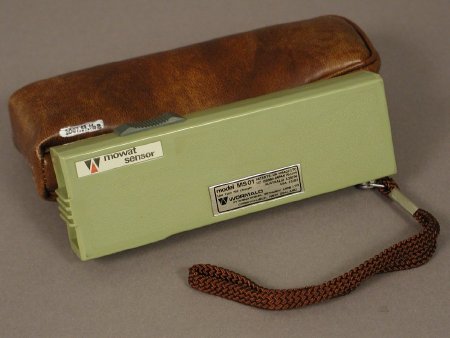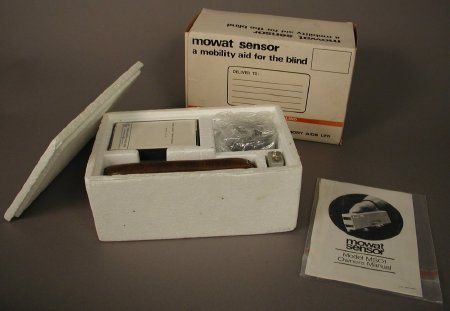Object ID:
2007.33.16
Title:
Mowat Sonar Sensor
Creator:
Wormald International Sensory Aids, Ltd
Description:
a) Sensor unit; celery green rectangular plastic case, textured sides; recessed screen on front covers two transducers, one an untra sonic emitter, the other a receiver; green plastic three-position slider; braided brown wrist strap on swivel post on side rear; battery compartment on back covers white 8.4v rechargible battery, cutout in cover for jack for recharging unit; label on side, "mowat sensor/model MS 01/WORMALD INTERNATIONAL SENSORY AIDS LTD/CHRISTCHURCH, NEW ZEALAND" and patent info; label inside battery compartment, "SERIAL No. S1/236"; (b) dark brown soft leatherette case with zipper closure, "mowat sensor" embossed on top; (c) owners manual on cassette tape; (d) black plastic charger unit and cord; (e) gray plastic rechargeable 8.4v transister battery; (f) print instruction manual in ziplock bag; (ghi) styrofoam cradle and lid inside white cardboard shipping box, "mowat sensor/a mobility aid for the blind/WORMALD INTERNATIONAL SENSORY AIDS LTD."
Dimensions:
H-2.125 W-1 D-6 inches
Date:
1978
Made by:
Wormald International Sensory Aids, Ltd; Mowat, Geoff
Place of Origin:
Christchurch, New Zealand
Provenance:
Invented in 1972 by Geoff Mowat of Auckland, NZ, the Mowat Sensor was developed commercially by Wormald International Sensory Aids Ltd (forerunner of Humanware) and introduced on the international market in 1977. The Mowat was distributed in the U.S. by Telesensory Systems. The device emits a beam of ultrasonic sound and detects its reflection from objects and obstacles. The Mowat vibrates when it detects objects within its range. The rate of vibration suggests the range of the obstacle from the user. Intended as a secondary ETA in conjunction with dog or cane, the Mowat was small enough to be carried in a pocket or purse until needed.
Credit Line:
Gift of Association for Education and Rehabilitation of the Blind and Visually Impaired

